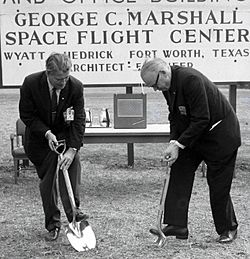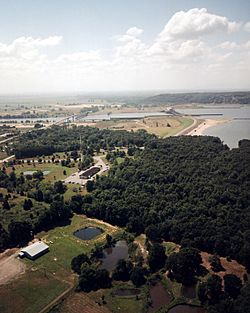Robert S. Kerr facts for kids
Quick facts for kids
Robert S. Kerr
|
|
|---|---|

Kerr in 1956
|
|
| United States Senator from Oklahoma |
|
| In office January 3, 1949 – January 1, 1963 |
|
| Preceded by | Edward H. Moore |
| Succeeded by | J. Howard Edmondson |
| 12th Governor of Oklahoma | |
| In office January 11, 1943 – January 13, 1947 |
|
| Lieutenant | James E. Berry |
| Preceded by | Leon C. Phillips |
| Succeeded by | Roy J. Turner |
| Personal details | |
| Born |
Robert Samuel Kerr
September 11, 1896 Ada, Indian Territory |
| Died | January 1, 1963 (aged 66) Washington, D.C., U.S. |
| Political party | Democratic |
| Spouses |
Reba Shelton
(m. 1919; died 1924)Grayce Breene
(m. 1925) |
| Relations | Travis M. Kerr (brother) Robert S. Kerr III (grandson) |
| Children | 4 |
| Education | East Central University (BA) |
| Military service | |
| Allegiance | |
| Branch/service | |
| Unit | Oklahoma National Guard |
| Battles/wars | World War I |
Robert Samuel Kerr (September 11, 1896 – January 1, 1963) was an important American businessman and politician from Oklahoma. He started a successful petroleum (oil and gas) company. Later, he became involved in politics. Kerr served as the 12th governor of Oklahoma from 1943 to 1947. He was also elected three times to the United States Senate.
Kerr focused on natural resources during his time in office. His most lasting achievement includes major water projects. These projects connected the Arkansas River to the Gulf of Mexico. He was also the first Oklahoma governor who was born in the state's territory.
Contents
Early Life and Business Success
Robert Kerr was born in a log cabin on September 11, 1896. This was in Pontotoc County, near what is now Ada. At that time, it was called Indian Territory. His father, William Samuel Kerr, was a farmer and politician. His mother was Margaret Eloda Wright.
Kerr's upbringing as a Southern Baptist greatly influenced his life. His religious beliefs led him to teach Sunday school. He also avoided alcohol throughout his life. This background helped his political career in Oklahoma, where Baptists were a large group.
He attended Oklahoma Baptist University and later graduated from East Central Normal School in Ada. He briefly studied law at the University of Oklahoma. However, he had to leave in 1916 due to financial difficulties.
When the United States entered World War I in 1917, Kerr joined the army. He became a second lieutenant. He did not fight in combat. However, his involvement in the Oklahoma National Guard and the American Legion helped his business and political future. After the war, he continued to study law and passed the bar exam in 1922.
In 1925, he married Grayce Breene. She was the youngest daughter of a wealthy family from Tulsa. They had four children together.
Starting an Oil Company
Kerr used his new family connections to enter the oil business. He partnered with his brother-in-law, James L. Anderson. By 1929, their company, Anderson-Kerr Drilling Company, was very successful. Kerr then left his law practice to focus only on oil.
In 1936, Anderson retired. Dean A. McGee, a former chief geologist, joined the company. In 1946, the company changed its name to Kerr-McGee Oil Industries, Incorporated. Kerr-McGee grew into a large company. It drilled for oil and processed other fuels and minerals around the world. These included uranium and helium.
Political Career in Oklahoma
Kerr's wealth and business connections made him a powerful figure in Oklahoma's Democratic Party in the 1930s. He helped raise money for Governors E.W. Marland and Leon C. Phillips. In 1940, he was chosen as Oklahoma's Democratic national committeeman.
Two years later, he ran for governor. He supported President Franklin D. Roosevelt's New Deal policies. He also believed America should play a strong role in World War II. Oklahoma's Democrats were divided, leading to a tough campaign. Kerr won the primary election by a small margin. He then won the general election, also by a small margin. He was the first governor born in Oklahoma.
Governor of Oklahoma
Kerr's four years as governor were a turning point for Oklahoma. For the first time, the governor and the state lawmakers worked well together. This was largely due to Kerr's patient leadership. He prepared Oklahoma for economic changes after the war.
Kerr traveled over 400,000 miles to promote Oklahoma's products and potential. This also helped his own political career. In 1944, he gave the main speech at the Democratic National Convention. He also helped choose Harry S. Truman as vice president.
During World War II, Kerr encouraged strong ties with the federal government. He knew this would bring jobs and activity to Oklahoma. Many wartime industries and military training sites came to the state. After the war, he pushed for more spending to help Oklahoma grow.
Moving to the U.S. Senate
Kerr used his success as governor to run for the U.S. Senate in 1948. He won a close race. He became the first Oklahoma governor to be elected to the Senate.
In the Senate, Kerr always put Oklahoma's interests first. He often focused on topics like oil policies and public works. He believed these issues would help Oklahomans the most. Unlike some others, he did not focus much on foreign affairs or civil rights. However, he did not sign the 1956 Southern Manifesto. He also voted for the Civil Rights Act of 1957 and the 24th Amendment.
Kerr briefly hoped to become president in 1952. But he did not win the Democratic nomination. After this, he focused completely on his work in the Senate.

Kerr quickly became known as a strong supporter of his region. He also defended the interests of his own oil company. His colleagues saw him as a brilliant debater. He could overwhelm opponents with his passion and knowledge of policy details.
He built strong alliances with powerful Southern and Western Democrats. These included Richard Russell, Jr. of Georgia and Lyndon B. Johnson of Texas. He relied heavily on these friends. He also prepared carefully for committee meetings to help his region's economy.
The McClellan–Kerr Arkansas River Navigation System became Kerr's most important goal. This huge federal project cost $1.2 billion. It was centered in northeastern Oklahoma. After it was finished in 1971, it brought over $3 billion in business and industry to the Arkansas River basin. This part of Oklahoma quickly became an important economic center.
Kerr also served on several key Senate committees. These included the Finance and Public Works committees. From 1961 until his death, he chaired the United States Senate Committee on Aeronautical and Space Sciences.
As an oil executive, Kerr strongly supported the petroleum and natural gas industries. He also promoted the wise use of natural resources. His father had told him, "To raise a family, you have to have three things – land, wood and water."

Kerr's legislative skills made him an important ally for President John F. Kennedy. They worked together on issues like space and taxes. However, on other issues, like Medicare, Kerr disagreed with the president. In January 1963, The Wall Street Journal wrote that "Mr. Kennedy asked; Mr. Kerr decided." This showed how much influence Kerr had.
Death
Robert Kerr passed away from a heart attack on January 1, 1963. After his death, an article called him "The Uncrowned King of the Senate." He was first buried in Oklahoma City. Later, his body was moved to the Kerr family home in Ada, Oklahoma.
Legacy and Impact
Kerr's main legacy for Oklahoma is a series of water projects and dams. These projects made the Arkansas River a navigable waterway. As governor, Kerr saw the damage caused by flooding from the Arkansas River. The river was too shallow for boats to reach Oklahoma.
His first bill in Congress created a commission to study land and water development in the region. He died before seeing the project finished. This project became the McClellan–Kerr Arkansas River Navigation System. It includes 18 locks and dams. This system made the waterway navigable from the Tulsa Port of Catoosa to the Mississippi River.
Many places in Oklahoma are named in Kerr's honor. These include schools, buildings, roads, and parks. A part of 2nd Street in downtown Oklahoma City is called Robert S. Kerr Avenue. The Carl Albert Center at the University of Oklahoma keeps Kerr's papers from his time as governor and senator.
In 1956, Senator Kerr was inducted into the Oklahoma Hall of Fame.
Kerr's death affected President Kennedy's plans in 1963. It also marked the end of the Democratic Party's strong control in Oklahoma politics. He left behind a large estate and a lasting impact. His strong use of the federal government to help his region grow helped connect the South and Southwest to the national economy. This growth of the "Sunbelt" changed many parts of American life. Robert Kerr played a big role in this transformation.
See also
- Bust of Robert S. Kerr
- List of United States Congress members who died in office (1950–99)



